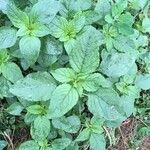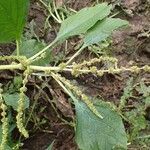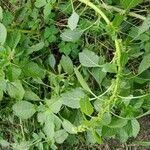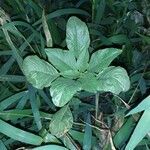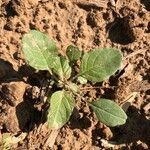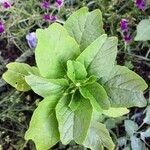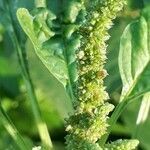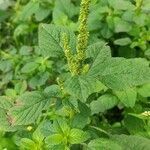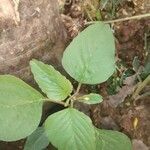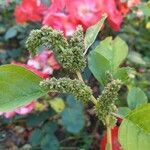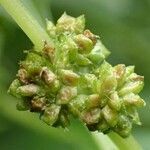Plants annual, glabrous. Stems ascending to prostrate, sometimes erect, simple or branched, sometimes radiating from base and forming mats, 0.1-0.6 m. Leaves: petiole usually equaling to 2 times as long as blade; blade ovate or obovate, 1-6 × 0.5-4 cm, base tapering or cuneate, margins entire, plane, apex distinctly emarginate to almost bilobate, mucronate. Inflorescences slender terminal spikes or panicles and also axillary clusters, in some forms only axillary clusters are present; spikes erect or sometimes reflexed, green , leafless at least distally. Bracts of pistillate flowers lanceolate, inconspicuous, 0.5 mm, shorter than tepals. Pistillate flowers: tepals 3, elliptic or spatulate, not clawed, equal or subequal, 0.8-1.5 mm, margins entire, apex broadly acute; style branches erect; stigmas 3. Staminate flowers clustered at tips of spikes; tepals 3; stamens 3. Utricles compressed, subglobose to obovate, 1.2-2.5(-3) mm, exceeding tepals, smooth or faintly rugose, indehiscent. Seeds black or dark reddish brown, subglobose or broadly lenticular, (0.8-)1-1.8 mm diam., smooth, shiny, filling fruit almost completely.
Stem ascending, light green or purple, 10-30 cm tall, branched from base, glabrous. Petiole 1-3.5 cm; leaf blade ovate or ovate-rhombic, 1.5-4.5 × 1-3 cm, base cuneate, margin entire or slightly undulate, apex notched, with a mucro. Flower clusters axillary, those of terminal clusters erect spikes or complex thyrsoid structures. Bracts and bracteoles oblong, shorter than 1 mm. Tepals light green, oblong or lanceolate, 1.2-1.5 mm, with a midvein adaxially, apex acute. Stamens slightly shorter than perianth; stigmas 3 or 2, falling off when utricles ripen. Utricles exceeding perianth, compressed-ovoid, ca. 3 mm, indehiscent, slightly rugose to nearly smooth. Seeds black to brownish black, circular, ca. 1.2 cm in diam. Fl. Jul-Aug, fr. Aug-Sep. 2n = 34.
Monoecious; stems prostrate to erect, to 6 dm; lvs rhombic-ovate to obovate, 1–3 cm, broadly retuse; petiole about equaling the blade; fls chiefly in axillary clusters, also in short (1–2 cm) terminal panicles; sep of pistillate fls 2, oblong, 1.5–2 mm, at the margins of the fr, a narrower and shorter third one often present at one side; fr broadly elliptic, 1.7–2.2 mm, thin-walled, indehiscent, smooth; seed suborbicular, 1–1.2 mm; 2n=34. An Old-World weed of unknown origin; occasionally found about seaports in our range, and at scattered stations in disturbed sites inland. (A. lividus)
An annual plant up to 1 m high. The leaf stalk is slender. The leaves are oval and 1-6 cm long. There are prominent veins under the leaf. The male and female flowers are separate but on the same plant. They are in a spike at the top of the plant. The male and female flowers are mixed. The flowers are green. The seeds are round and 1-1.8 mm across. They are dark brown to black.
